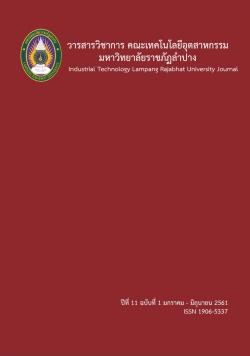Design and Construction of a Household Shredder
Keywords:
Design, Cutting Machine, Household vegetative residuesAbstract
Agricultural residue and by-products are often the wrong size to be reused in agriculture or as alternative fuel sources, and therefore need to be shredded into smaller pieces. However, cutting machines are generally too large and are unsuitable for household usage. Hence, this invention is aimed at the design and the construction of a the prototype shredding machine for household food waste. The procedure began from applying the theory of shear stress and carried out the performance tests focusing on the size of the products as small, medium and large. Subsequently, the experiments were performed to determine the optimum speed of the blade at 417, 500, 700, 900, or 983 rpm. Also, the moisture content in material affecting the cut was small in size. It was found that the optimum speed was 763 rpm which had a capacity to shred material at 46.2 – 120 kg/hour of the small size corresponding to 65% ± 3.5. The cutting of lemongrass and Chinese morning glory was a minimum of 46.2 kg/hour and a maximum of 120.0 kg/hour respectively. The machine can shred into small sizes accomplishing the objective and with an energy consumption is 0.001– 0.003 kW–h/kg. The total cost is 18,500 baht. The average annual operating costs are 11,788 baht corresponding to 0.35 baht per cost of unit of production. Therefore, this invention has a low cost and a good capability according to more than 50%.
References
Kumar, S., & Kumar, H., (2015). Design and development of agricultural waste shredder machine. IJISET– International Journal of Innovative Science, Engineering & Technology. 2(10), pp. 164–167.
Nakarin Bangkok Co. LTD. (2012). Multipurpose shredder NO.QC004.Retrieved January 14, 2017 from http://www.nakarinbangkok.com (in Thai)
Persson, S., (1987). Mechanics of cutting plant material. United States of America: American Society of Agricultural Engineering.
Soponronnarit, S., (1997). Drying Grains and Some Types of Foods, 7th ed. Bangkok: King Mongkut's Institute of Technology Thonburi. (in Thai)
Suttiwatana, P. & Wongkaew, D., (2009). Research and development of water Hyacinth-cutting machine from prototype with community participatation.Research Journal, 2(1), 1–8. (in Thai)
Tunhaw, M. Tinimgoon, K.,& Sirimala,R., (2011). Design and Development of a peanut chopper. KhonKaen Agr. Journal, 39(3), 60–65. (in Thai)
Yaemphuan, P., (2005). Engineering Economy. Bangkok: SE–Ed. Public Co. Ltd. (in Thai)






